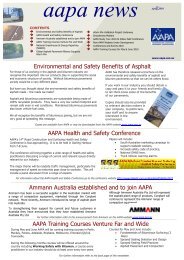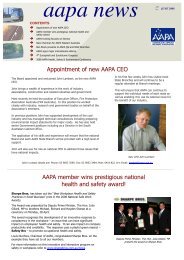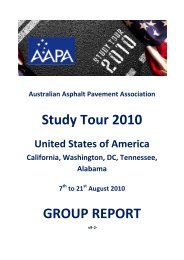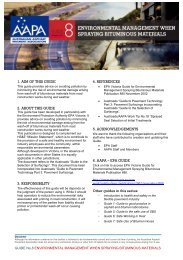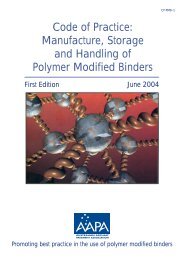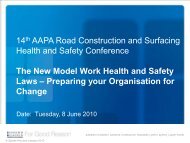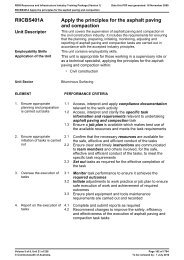Asphalt Review - Feb/March 2013 - Australian Asphalt Pavement ...
Asphalt Review - Feb/March 2013 - Australian Asphalt Pavement ...
Asphalt Review - Feb/March 2013 - Australian Asphalt Pavement ...
Create successful ePaper yourself
Turn your PDF publications into a flip-book with our unique Google optimized e-Paper software.
ASPHALT REVIEW<br />
Temporary public access is always required and on this project<br />
they will be established to a high standard of surfacing to accommodate<br />
disabled persons, elderly and those with need for wheeled walkers<br />
and prams. The new public access paths have been well delineated<br />
and signed.<br />
High security type fencing has been deployed on site to better<br />
contain and separate the public from road construction plant and<br />
vehicles. This is more effective than para-webbing or bunting flags in<br />
the containment of pedestrians and is less prone to weather damage.<br />
Public walkway on right behind security fence<br />
A motorised wheel chair passes over the temporary walkway without difficulty – the<br />
surfacing will be further sealed.<br />
The safety challenge presented by work near<br />
overhead and underground services<br />
Most utility services are placed in the road reserves and contact with<br />
underground and overhead utility services was far too frequent in past<br />
years during road construction and similar works.<br />
Activities which have shown the potential to strike services include:<br />
• Excavation works with excavators or backhoes;<br />
• Scraping or grading works;<br />
• Pile and post driving;<br />
• Coring and geotechnical studies;<br />
• Auger works; and<br />
• Steel pickets<br />
It was also common practice prior to 2004 to use plant such as<br />
excavators and backhoes to probe for underground services, often with<br />
predictable negative consequences and damage to services.<br />
VicRoads worked with our contractors in the major projects area<br />
to identify controls and best practice approaches in the civil road<br />
construction area, applying the WorkSafe Framework and Supporting<br />
Publications as the foundation guidelines.<br />
The VicRoads Worksite Safety Newsletter and Safety Alerts were used to<br />
communicate identified best practices for the benefit of the construction<br />
industry and this has significantly eliminated contacts as a result.<br />
Individual behaviour remains the major cause of incidents and this<br />
presents a major challenge.<br />
What was evident during the development of the WorkSafe<br />
Framework was the significant dependence on behavioural controls<br />
in this area. Under the hierarchy of safety controls, behavioural or<br />
administrative controls are clearly the least reliable and effective.<br />
However, higher level controls need to be practical and available in<br />
construction equipment to remove our reliance on human behaviour.<br />
For overhead electrical assets the WorkSafe Handbook for Using<br />
Earthmoving Equipment near Overhead Electrical Assets describes the<br />
hierarchy of controls and gives examples applicable to this equipment<br />
which is frequently involved in contacts with overhead services.<br />
Elimination of the risk through relocation of services prior to road<br />
construction work commencing is now frequently used, but does<br />
require cooperation by the relevant asset owner. Isolation of services is<br />
also used where practical, particularly where works could intrude into<br />
the No Go Zone for overhead electrical services.<br />
There have been innovations in the engineering control areas with<br />
respect to height limiters of excavators which show promise, but may<br />
require a different approach to the task if they cannot reach high<br />
enough to load trucks directly.<br />
Underground service contact incidents have been more prevalent<br />
than overhead services in VicRoads’ experience although both have<br />
significantly reduced in general.<br />
Actions required by contractors to<br />
comply with WorkSafe Framework<br />
The best practice approach to excavation work must follow the<br />
WorkSafe Framework for Undertaking Work near Overhead and<br />
Underground Assets. Industry standards for construction works have<br />
not yet been agreed so in the interim the best practice approach as<br />
detailed in the WorkSafe Framework must be followed or exceeded.<br />
Contractors’ documented safe working procedures must reflect the safe<br />
systems of work specified in the WorkSafe Framework. These detailed<br />
procedures must clearly describe how the system of work will comply with<br />
the WorkSafe Framework and include as-constructed drawings rather than<br />
schematics when possible or a larger size plan that is easy to read.<br />
Permits to Excavate are now commonly required by the principal<br />
contractors to ensure that all safety procedures have been<br />
implemented prior to the works commencing. The procedures should<br />
include requirements to:<br />
• Dial before You Dig;<br />
• “Prove” the location of services using appropriate non-destructive<br />
excavation technology;<br />
• Positively mark the services locations when they have been positively<br />
“proved”;<br />
• Record new locations when services are relocated for future<br />
reference;<br />
• Not permit machines to work closer than the distances listed in the<br />
WorkSafe Framework unless permission has been given by the asset<br />
owner;<br />
• Not assume services are laid in a straight line or that the depth will<br />
be consistent;<br />
• Undertake non-destructive proving excavation if some services are<br />
not traceable;<br />
28 ROADS FEB/MARCH <strong>2013</strong>



